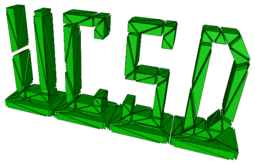| Michael Holst | ||
| https://ccom.ucsd.edu/~mholst/ |
Distinguished Professor of Mathematics and Physics UC San Diego |
|
|
Math 210C (Mathematical Methods in Physics and Engineering III)
Instructor: Prof. Michael Holst (5739 AP&M, mholst@math.ucsd.edu) Term: Spring 2016 Lecture: 1:00p-1:50p MWF, TBA Office Hours: 2:00p-2:50p M, 5739 AP&M Class webpage: http://ccom.ucsd.edu/~mholst/teaching/ucsd/210c_s16/ Textbooks/References:
COURSE DESCRIPTION: The following is a brief description of the course. Note that the UCSD catalog currently has a very dated description of this course that was written a couple of decades ago. Our goal for the course remain the same as for the original course: provide graduate researchers in applied mathematics, physics, science, and engineering with a more sophisticated and powerful set of mathematical tools for performing their research. However, we will update some of the topics to reflect changes in the mathematical tools needed for modern science and engineering research; obvious examples being the growing importance of simulation algorithms over the last two decades, and the more recent emergence of data science techniques in all areas of science and engineering research. The prerequisites for the course remain the same as for the older description of the course. 210C. Mathematical Methods in Physics and Engineering (4) Prerequisites: Math 210B or consent of instructor. PLANNED TOPICS FOR 210C (SPRING 2016):
GRADES, HOMEWORKS, EXAMS, AND IMPORTANT DATES: Course information, such as the planned lecture topics for the week, any homework assignments, and so forth, will be maintained on this class webpage. Note that I sometimes make minor changes to both the lectures and homework assignments as the quarter progresses, based on how much I am able to cover in the lectures, and which directions we go based partially on the interests of the students. Therefore, CHECK THE WEBPAGE FREQUENTLY. The course will be graded on attending most of the lectures, doing some homework assignments, and a final "take home" examination, according to the following guidelines:
The "participation in class" part of the course is that I simply want you to try to come to most of the lectures; that will give you full marks on that part of the grade. (I will not actually take attendence; you are all adults.) The "homeworks" will be based on the lectures, and will just give you the opportunity to use some of the tools we go over in the lecture. They will not be particularly time-consuming; they are for your benefit. Similar to the participation metric, if you make a good attempt on the homework then I will give you full marks. (I do not plan to formally grade the homeworks, but will try to give you feedback if you feel you need it.) The final will be a "take home" exam, which will simply be some problems from the list of homework problems (that you may have already worked on during the quarter). During the actual scheduled time of the final exam for 210C, I will be in my office and can answer any last-minute questions about problems on the take home final. (I will also have some coffee available for anyone who comes by...) Here are some important dates:
TAKE HOME EXAM (Announced in Class Friday 06/03/16): This quarter the take-home final exam in 210C consists of working out a total of eight of the assigned homework problems that were listed above as HW1-3. You are completely free to select your eight problems from the list of problems I assigned in the Homeworks, EXCEPT that you must choose three from each of HW1 and HW2 (six of the eight problems), and two from HW3. That way you will be challenged to learn a little bit about each of the major sections of the material that we covered this quarter. HW3 are problems on exterior calculus, which we have only barely begun in the lectures. But, all of this material is very standard, and can be found in all four of the books listed for the course, and also in my lecture notes (I will post a scanned version as soon as I can). The best resource is actually the book by Ted Frankel (a now retired UCSD professor); I have a link to the electronic version (free to all UCSD students) at the top of this webpage. By pushing you to look at the exterior calculus problems just a little bit, my hope is to get you interested enough to pursue reading on your own this summer. Some comments on the final exam problems:
Early in the quarter the department asked all instructors not giving formal final exams to give up their assigned final exam room to the department for use as OSD exam spaces, and our room is being used for this. The department is really short of space for these exams during finals, together with hosting large review sections for lower division courses, so all rooms are actually scheduled the entire day. If anyone has not had enough of tensors and p-forms by the end of this week, I will offer to you a personal 1-hour lecture any afternoon next week :). |
